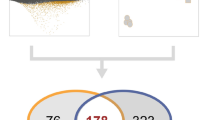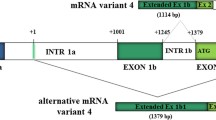Abstract
Autosomal recessive polycystic kidney disease (ARPKD) results from mutations in the human PKHD1 gene. Both this gene, and its mouse ortholog, Pkhd1, are primarily expressed in renal and biliary ductal structures. The mouse protein product, fibrocystin/polyductin complex (FPC), is a 445-kDa protein encoded by a 67-exon transcript that spans >500 kb of genomic DNA. In the current study, we observed multiple alternatively spliced Pkhd1 transcripts that varied in size and exon composition in embryonic mouse kidney, liver, and placenta samples, as well as among adult mouse pancreas, brain, heart, lung, testes, liver, and kidney. Using reverse transcription PCR and RNASeq, we identified 22 novel Pkhd1 kidney transcripts with unique exon junctions. Various mechanisms of alternative splicing were observed, including exon skipping, use of alternate acceptor/donor splice sites, and inclusion of novel exons. Bioinformatic analyses identified, and exon-trapping minigene experiments validated, consensus binding sites for serine/arginine-rich proteins that modulate alternative splicing. Using site-directed mutagenesis, we examined the functional importance of selected splice enhancers. In addition, we demonstrated that many of the novel transcripts were polysome bound, thus likely translated. Finally, we determined that the human PKHD1 R760H missense variant alters a splice enhancer motif that disrupts exon splicing in vitro and is predicted to truncate the protein. Taken together, these data provide evidence of the complex transcriptional regulation of Pkhd1/PKHD1 and identified motifs that regulate its splicing. Our studies indicate that Pkhd1/PKHD1 transcription is modulated, in part by intragenic factors, suggesting that aberrant PKHD1 splicing represents an unappreciated pathogenic mechanism in ARPKD.
Key messages
-
Multiple mRNA transcripts are generated for Pkhd1 in renal tissues
-
Pkhd1 transcription is modulated by standard splice elements and effectors
-
Mutations in splice motifs may alter splicing to generate nonfunctional peptides








Similar content being viewed by others
References
Zerres K, Mucher G, Becker J, Steinkamm C, Rudnik-Schoneborn S, Heikkila P, Rapola J, Salonen R, Germino GG, Onuchic L et al (1998) Prenatal diagnosis of autosomal recessive polycystic kidney disease (ARPKD): molecular genetics, clinical experience, and fetal morphology. Am J Med Genet 76:137–144
Guay-Woodford LM, Desmond RA (2003) Autosomal recessive polycystic kidney disease: the clinical experience in North America. Pediatrics 111:1072–1080
Onuchic LF, Furu L, Nagasawa Y, Hou X, Eggermann T, Ren Z, Bergmann C, Senderek J, Esquivel E, Zeltner R et al (2002) PKHD1, the polycystic kidney and hepatic disease 1 gene, encodes a novel large protein containing multiple immunoglobulin-like plexin-transcription-factor domains and parallel beta-helix 1 repeats. Am J Hum Genet 70:1305–1317
Nagasawa Y, Matthiesen S, Onuchic LF, Hou X, Bergmann C, Esquivel E, Senderek J, Ren Z, Zeltner R, Furu L et al (2002) Identification and characterization of Pkhd1, the mouse orthologue of the human ARPKD gene. J Am Soc Nephrol 13:2246–2258
Bakeberg JL, Tammachote R, Woollard JR, Hogan MC, Tuan HF, Li M, van Deursen JM, Wu Y, Huang BQ, Torres VE et al (2011) Epitope-tagged Pkhd1 tracks the processing, secretion, and localization of fibrocystin. J Am Soc Nephrol 22:2266–2277
Wang S, Luo Y, Wilson PD, Witman GB, Zhou J (2004) The autosomal recessive polycystic kidney disease protein is localized to primary cilia, with concentration in the basal body area. J Am Soc Nephrol 15:592–602
Ward CJ, Yuan D, Masyuk TV, Wang X, Punyashthiti R, Whelan S, Bacallao R, Torra R, LaRusso NF, Torres VE et al (2003) Cellular and subcellular localization of the ARPKD protein; fibrocystin is expressed on primary cilia. Hum Mol Genet 12:2703–2710
Menezes LFC, Cai Y, Nagasawa Y, Silva AMG, Watkins ML, Da Silva AM, Somlo S, Guay-Woodford LM, Germino GG, Onuchic LF (2004) Polyductin, the PKHD1 gene product, comprises isoforms expressed in plasma membrane, primary cilium, and cytoplasm. Kidney Int 66:1345–1355
Nilsen TW, Graveley BR (2010) Expansion of the eukaryotic proteome by alternative splicing. Nature 463:457–463
Kalsotra A, Cooper TA (2011) Functional consequences of developmentally regulated alternative splicing. Nat Rev 12:715–729
Lin S, Fu XD (2007) SR proteins and related factors in alternative splicing. Adv Exp Med Biol 623:107–122
Zhou Z, Fu XD (2013) Regulation of splicing by SR proteins and SR protein-specific kinases. Chromosoma 122:191–207
Cooper TA, Wan L, Dreyfuss G (2009) RNA and disease. Cell 136:777–793
Sterne-Weiler T, Howard J, Mort M, Cooper DN, Sanford JR (2011) Loss of exon identity is a common mechanism of human inherited disease. Genome Res. doi:10.1101/gr.118638.110
Poulos MG, Batra R, Charizanis K, Swanson MS (2011) Developments in RNA splicing and disease. Cold Spring Harbor Perspect Biol 3:a000778
Trapnell C, Williams BA, Pertea G, Mortazavi A, Kwan G, van Baren MJ, Salzberg SL, Wold BJ, Pachter L (2010) Transcript assembly and quantification by RNA-Seq reveals unannotated transcripts and isoform switching during cell differentiation. Nat Biotechnol 28:511–515
Robinson JT, Thorvaldsdottir H, Winckler W, Guttman M, Lander ES, Getz G, Mesirov JP (2011) Integrative genomics viewer. Nat Biotechnol 29:24–26
Reese MG, Eeckman FH, Kulp D, Haussler D (1997) Improved splice site detection in Genie. J Comput Biol 4:311–323
Cartegni L, Wang J, Zhu Z, Zhang MQ, Krainer AR (2003) ESEfinder: a web resource to identify exonic splicing enhancers. Nucleic Acids Res 31:3568–3571
Yeo GW, Van Nostrand E, Holste D, Poggio T, Burge CB (2005) Identification and analysis of alternative splicing events conserved in human and mouse. Proc Natl Acad Sci U S A 102:2850–2855
Burn TC, Connors TD, Klinger KW, Landes GM (1995) Increased exon-trapping efficiency through modifications to the pSPL3 splicing vector. Gene 161:183–187
Masek T, Valasek L, Pospisek M (2011) Polysome analysis and RNA purification from sucrose gradients. Methods Mol Biol (Clifton, NJ) 703:293–309
Kafasla P, Mickleburgh I, Llorian M, Coelho M, Gooding C, Cherny D, Joshi A, Kotik-Kogan O, Curry S, Eperon IC et al (2012) Defining the roles and interactions of PTB. Biochem Soc Trans 40:815–820
Coolidge CJ, Seely RJ, Patton JG (1997) Functional analysis of the polypyrimidine tract in pre-mRNA splicing. Nucleic Acids Res 25:888–896
Yeo G, Holste D, Kreiman G, Burge CB (2004) Variation in alternative splicing across human tissues. Genome Biol 5:R74
Aachen University R (2013) Mutation Database Autosomal Recessive Polycystic Kidney Disease (ARPKD/PKHD1). Department of Human Genetics, RWTH Aachen University, Pauwelsstraße 30, D-52074 Aachen, Germany
Williams SS, Cobo-Stark P, James LR, Somlo S, Igarashi P (2008) Kidney cysts, pancreatic cysts, and biliary disease in a mouse model of autosomal recessive polycystic kidney disease. Pediatric Nephrol (Berlin, Germany) 23:733–741
McMahon A, Aronow B, Davidson D, Davies J, Gaido K, Grimmond S, Lessard J, Little M, Potter S, Wilder E et al (2008) GUDMAP: the genitourinary developmental molecular anatomy project. J Am Soc Nephrol 19:667–671
Moser M, Matthiesen S, Kirfel J, Schorle H, Bergmann C, Senderek J, Rudnik-Schoneborn S, Zerres K, Buettner R (2005) A mouse model for cystic biliary dysgenesis in autosomal recessive polycystic kidney disease (ARPKD). Hepatology (Baltimore, Md) 41:1113–1121
Gallagher AR, Esquivel EL, Briere TS, Tian X, Mitobe M, Menezes LF, Markowitz GS, Jain D, Onuchic LF, Somlo S (2008) Biliary and pancreatic dysgenesis in mice harboring a mutation in Pkhd1. Am J Pathol 172:417–429
Woollard JR, Punyashtiti R, Richardson S, Masyuk TV, Whelan S, Huang BQ, Lager DJ, vanDeursen J, Torres VE, Gattone VH et al (2007) A mouse model of autosomal recessive polycystic kidney disease with biliary duct and proximal tubule dilatation. Kidney Int 72:328–336
Sharp AM, Messiaen LM, Page G, Antignac C, Gubler MC, Onuchic LF, Somlo S, Germino GG, Guay-Woodford LM (2005) Comprehensive genomic analysis of PKHD1 mutations in ARPKD cohorts. J Med Genet 42:336–349
Rossetti S, Harris PC (2007) Genotype-phenotype correlations in autosomal dominant and autosomal recessive polycystic kidney disease. J Am Soc Nephrol 18:1374–1380
Zvereff V, Yao S, Ramsey J, Mikhail FM, Vijzelaar R, Messiaen L (2010) Identification of PKHD1 multiexon deletions using multiplex ligation-dependent probe amplification and quantitative polymerase chain reaction. Genetic Testing Mol Biomark 14:505–510
Acknowledgments
The authors acknowledge Drs. Mary Ann Accavitti, Feng Qian, Brad Yoder, and members of the Guay-Woodford laboratory for their helpful advice. This work was supported by the NIDDK and the NIDDK intramural program (R01DK51259 and ZIA DK75042) to G.G.G., the UAB Hepato-Renal Fibrocystic Disease Core Center (P30 DK074038) to LGW, from the Foundation for Research Support of the State of São Paulo (2004/02622-0 to L.O.) and by the NIH-funded UAB Center for Clinical and Translational Science (UL1 RR025777). The authors have no conflicts to disclose.
Author information
Authors and Affiliations
Corresponding author
Electronic supplementary material
Below is the link to the electronic supplementary material.
ESM 1
(DOCX 505 kb)
Supplemental Figure 1
RT-PCR data from Pkhd1 lacZ/lacZ mice suggests alternative transcript production. RT-PCR was performed on total RNA isolated from 9-month-old Pkhd1 lacZ/lacZ kidney samples [27] (animals 7 Pkhd1 lacZ/lacZ and 8 Pkhd1 lacZ/lacZ) using primer pairs designed to amplify sequence spanning exons 50–67 and exons 38–52. a Pkhd1 exon 50–67 primers generate an amplicon of 3.5 kb in both Pkhd1 lacZ/lacZ and WT mice. The integrity of the large-sized RNA was validated with Prkdc primers (9 kb product). b Pkhd1 exon 38–52 primers generated a 2.1 kb amplicon in mouse 8 Pkhd1 lacZ/lacZ and WT. Boxes indicate Pkhd1 amplicons present in presumed null animals. A second 400 bp product was amplified from Pkhd1 lacZ/lacZ 8 RNA and was determined to represent a nonspecific amplicon by sequencing. Asterisk denotes non-specific amplicons. (PDF 598 kb).
Rights and permissions
About this article
Cite this article
Boddu, R., Yang, C., O’Connor, A.K. et al. Intragenic motifs regulate the transcriptional complexity of Pkhd1/PKHD1 . J Mol Med 92, 1045–1056 (2014). https://doi.org/10.1007/s00109-014-1185-7
Received:
Revised:
Accepted:
Published:
Issue Date:
DOI: https://doi.org/10.1007/s00109-014-1185-7




